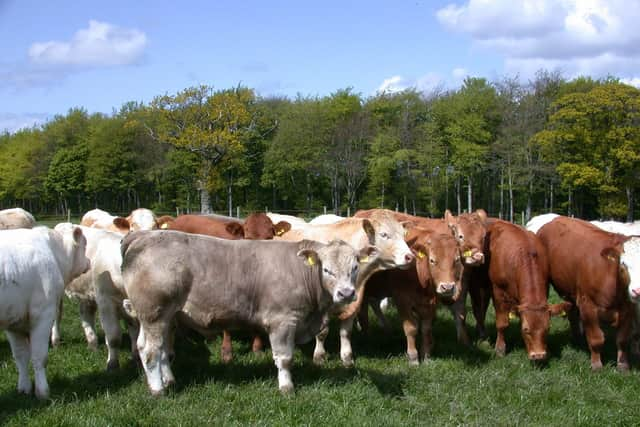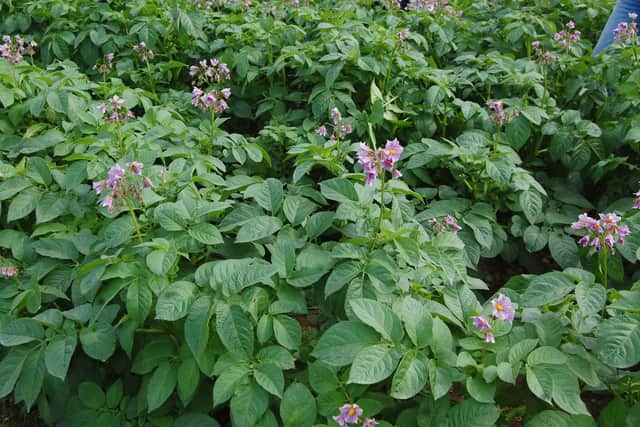The race towards organic farming continues apace across Europe
and live on Freeview channel 276
They are doing this because the general public perceive this as a more natural form of food production.
But more than this, farmers see organic as a way of maximising the prices they receive for their produce.
Advertisement
Advertisement
The ‘organic farming’ discussion has been kick started at a time when many farmers in countries like France and Germany view this form of food production as a means of shielding their businesses from the worst excesses of climate change.


A case in point is the fact that increasing numbers of German dairy farmers are switching from conventional to organic milk production.
For many it’s not a case of securing a better farm gate price: the real driver is a desire to produce milk in what they regard is a more natural and sustainable manner.
However, some farmers have taken this principle to a higher level again by feeding their cows high-quality, barn-dried hay as the sole source of winter forage.
Advertisement
Advertisement
One such farmer is Rüdiger Pöhl, who milks 70 Fleckvieh cows close to the village Gottberg in north eastern Germany.


The farm extends to 270ha. In addition to the grass and hay produced for the cows and young stock, Pöhl produces 30t of organic hemp seed and 40t of sunflower seed on an annual basis. Organic barley is also grown on the farm.
The cows are milked by a single robot: they are currently producing 6,500L per lactation. Approximately 4kg of organic concentrates are fed to the cows in the milking group per day.
The herd is zero-grazed throughout the spring and summer period. The forage is changed to hay for the rest of the year.
Advertisement
Advertisement
Pöhl made the switch to organic in 2009. Prior to this he had been milking 116 cows.
He sells his milk in two ways. The bulk of his output goes to a local processors, currently paying 57c/L. This includes a bonus that reflects the commitment to both organic production standards and the use of home-grown hay as a winter feed.
The family also operates a milk vending machine at the farm, which is available to members of the public on a 24:7 basis.
Customers pay €1.20/L for the unpasteurised milk. But they must bring their own bottle or container. Sales volumes from the vending machine are currently averaging 50L/day.
Advertisement
Advertisement
Two cuts of high quality hay are made each year. This year’s first crop was made on June 28th at a very leafy stage of growth. The forage has a crude protein value of 11%.
The grass is round-baled in the field and then taken for drying. The drying facility on the farm can handle up to 40 bales at a time.
Kerosene has been the traditional fuel used for the grass drying operation. However, recent years have seen the greater use of recycled, warm air within the drying plant in tandem with the increasing use of electricity.
Bales can be taken up to 80% dry matter levels within 8 hours. It is currently costing Rüdiger €3 to dry each bale.
Advertisement
Advertisement
Organic hay milk has a very sweet and appealing taste. In part, this is due to its high fat content, a direct consequence of the high fibre levels within the forage.
Meanwhile, a recent edition of the Teagasc Tillage Edge podcast looked in detail at the feasibility of expanding the organic crops sector in Ireland.
Ireland still has a relatively small organic sector. And in relative terms, the tillage sector plays an even smaller role.
Significantly, all of Ireland’s organic beef and sheep farmers are required to feed concentrate of a similar status.
Advertisement
Advertisement
So, in theory, the potential to develop an organic crops’ sector in the country is significant.
There are also obvious synergies between livestock and tillage farming, where the recycling of animal manures are concerned.
However, running a stock-less organic tillage farm is more challenging.
Martin Bourke is a specialist organic tillage advisor with Teagasc. Courtesy of the podcast, he explained the pros and cons of converting from a conventional to an organic cropping business.
Advertisement
Advertisement
But before getting into the technical detail of this process, Bourke started by referencing the growth targets that have been set by the EU, regarding the development of organic tillage across Europe.
“The EU has committed to having 20% of the land in Europe farmed organically by 2030,” he confirmed.
“Ireland at the moment is only at about 2%. But a national target has been set to get this figure up to 7½% by 2027.”
Bourke continued:“This is an ambitious target. However a total of €256m has been put into a fund to boost organic farming in Ireland by the Department of Agriculture.
Advertisement
Advertisement
“Back in 2019 there were 134 organic cereal growers in Ireland. But we know that this figure has climbed by between 25 and 30 since then.”
According to Bourke, Teagasc is expecting a significant number of additional tillage farmers to switch from conventional growing systems. Driving this will be the support funding available through Ireland’s new Organic farming Scheme.
Across in England, Scotland and Wales it has been revealed that land going through the two-year conversion period to organic rose by 34% in 2021, compared to the previous year.
UK organic land also rose by 3.6% last year, relative to 2021.
Advertisement
Advertisement
Sophie Kirk, Business Development Manager for Soil Association Certification, said: “It is encouraging to see that the latest statistics show confidence in organic farming is on the rise in the UK.
“Our farming sector has dealt with many shocks over the last few years but opportunities for sustainable farming remain strong with rising consumer demand and government support for organic.
“It is clear both government and shoppers are waking up to the benefits organic can deliver for nature and the environment, and these latest figures show that, with the right incentives, nature and climate friendly farming can grow rapidly.”
The rise in organic farming last year is expected to continue in 2023 after the government announced that they would pay up to double the previous rates to farmers in England who convert to organic.
Advertisement
Advertisement
All payments for organic farming are rising by between 50 and 500% for those entering a new scheme with Countryside Stewardship, which is open for applications until July.
This also follows the UK organic market breaking the £3 billion mark for the first time ever in 2021 – growing by 23% from 2019 to 2021, and significantly out-performing non-organic sales.
Kirk added: “Currently more ingredients and products are imported to support the increased demand for organic food. We need robust UK supply chains to support more organic production at home, particularly as our research shows consumers want to buy British.
“The long-term goals that government has set out for agriculture, with a new focus on protecting soils, wildlife and the environment, are in harmony with the principles of organic farming.
Advertisement
Advertisement
“Alongside continued growth in the organic market, this should give any farmer greater confidence to switch to or maintain organic farming practices, despite the short-term uncertainty facing every farm.”
The UK organic food market has been values at around £1.50bn. Spend on organics per trip continued to increase. Last year, an average of £3.50 per shopping trip was spent on organic products.
Traditional organic categories continue to see growth. Dairy is achieving a 12.1% annual growth rate while a 15.7% annual growth rate is being achieved in the fresh produce category.
But according to recent research data, there are tremendous opportunities to grow all of this much further.
Advertisement
Advertisement
The Kantar organisation has confirmed that the uptake in online shopping can benefit organic. Organic produce can be more easily searched for online when compared with shopping in store.
If the 10% of 6.6 million shoppers that already purchase one organic product were to buy two organic products, this would generate £3.7m for the UK’s organic market.
Research suggests that there is a one in three chance that this second product would be in the dairy category. Approximately 50% of millennials are more likely to buy organic products post-COVID-19.
Research also suggests that 40% of UK consumers are concerned about the environment but are not making the connection to organic.
But is organic food better for one’s health?
Advertisement
Advertisement
Studies in the United States have confirmed small to moderate increases in some nutrients in organic produce. Organic produce may have more of certain antioxidants and types of flavonoids, which have antioxidant properties.
The feeding requirements for organic farm animals usually cause higher levels of omega-3 fatty acids. These include feeding cattle grass and hay. Omega-3 fatty acids — a kind of fat — are more heart healthy than other fats. These higher omega-3 fatty acids are found in organic meats, dairy and eggs.
Cadmium is a toxic chemical naturally found in soils and absorbed by plants. Studies have shown much lower cadmium levels in organic grains, but not fruits and vegetables, when compared with crops grown using conventional) methods. The lower cadmium levels in organic grains may be related to the ban on synthetic fertilizers in organic farming.
And, finally, compared with produce grown using conventional methods, organically grown produce may have lower levels of pesticide residue.
Advertisement
Advertisement
Agriculture in Northern Ireland has been slow to adopt organic farming practises. But this may well change in the very near future.
The EU has now firm targets in place which will see just short of 8.0% of all Europe’s available land area farmed organically by the end of the current decade.
But the fact remains that organic farming practises do deliver a premium market return for primary producers.
Here in Northern Ireland, the potential for Westminster to step-in and offer higher levels of support to local agriculture are remote.
Advertisement
Advertisement
As a result, farmers here will be more dependent than ever on market returns. And how is all that working out at the present time?
I sense that local dairy and pig producers would have a very negative perspective on just how pressurising it has been to work within the confines of the world’s food commodity markets over recent months.
Organic, on the other hand, takes farmers out of this scenario altogether; aligning them more closely to consumer demands. The end result of this process should be higher farm gate returns on a consistent basis.